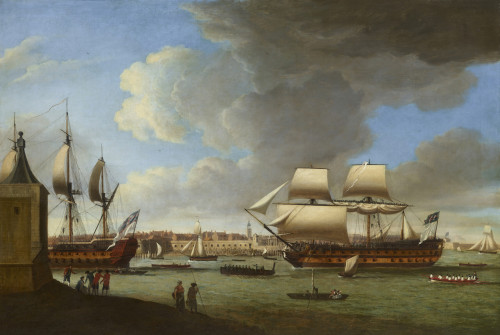The Wake of the Tug
The Wake of the Tug
155275
WILLIAM AYERST INGRAM RBA, RI, ROI
1855-1913
English School
“The Wake of the Tug”
Oil on canvas, signed
38.2 x 76cms
15 x 30 inches
Overall framed dimensions
Exhibited Royal Academy 1888 no. 1108
It was not until recently that, following the unearthing of the birth certificate, it was confirmed that William Ayerst Ingram was born in Twickenham on 27th April 1855, the son of the Rev G. S. Ingram and brother of R.S.Ingram. Until then, it had been assumed that he was born in Glasgow but the confusion may have arisen because his father, who was the vicar in Twickenham, was originally from the Scottish city.
Apparently he travelled to Australia when still a boy and this must have instilled a wanderlust which was evident throughout his life and he returned to Australia in the 1880s and 90s to paint and exhibit. He moved to central London to undertake his artistic training under the instruction of the landscape and coastal scene painter John Steeple and the landscape watercolourist Augustus Walford Weedon and began his career predominantly as a landscape painter. His first studio was close to that of the sculptor, portraitist and history painter George Percy Jacomb-Hood and they became good friends.
Ingram used both oils and watercolours in his work and Martin Hardie, in his three volume opus "Watercolour Painting in Britain" writes of him: "Much of his work was in oil, but his watercolour drawings of subjects found on the coast and the open sea have a quiet accomplishment…" The lure of depicting water and its shifting movement and light is exemplified by his hiring a sailing boat with a full crew in 1884 to journey from the Needles to Falmouth so as to sketch as they went.
He travelled extensively in search of subject matter for his paintings and the majority depict coastal and river estuary scenes as well as landscapes. He exhibited from 1880 onwards at the Royal Academy (44 paintings), 143 times at the Royal Society of British Artists, 51 at the New Watercolour Society, 53 at the Royal Institute, 23 at the Liverpool art Gallery, at the Fine Art Society in 1888 and 1902 and the Dowdeswell Gallery in 1911 and 1914 as well as several other venues including a well-received exhibition in Paris in 1886 entitled "Two Years Afloat".
In 1883, he was elected a full member of the Royal Society of British Artists. In 1907 he became a full member of the Royal Institute and in 1906 of the Royal Institute of Painters in Oil-Colours. He was a founder member of the Royal British Colonial Society of Artists and became its President in 1888.
Ingram lived in several addresses in London including Chelsea, Maida Vale as well as Surbiton, but apart from his European trips, much of his time was spent painting in the West Country, particularly around Brixham, St Ives and Falmouth.and he moved down there permanently in 1882. He opened the Falmouth Art Gallery in 1894 with the renowned Newlyn School painter Henry Scott Tuke. The founding of this gallery combined with the close association both artists had with the Newlyn School, enabled them to attract significant painters to exhibit there. These included Thomas Cooper Gotch, John Singer Sargent, Stanhope Alexander Forbes, James Abbott Mcneill Whistler, Charles Napier Hemy and Sophie Anderson.
Whistler and Ingram had been friends prior to this however and Whistler had come down to Newlyn together with Walter Sickert and Mortimer Menpes in 1883. When the former was elected President of the RBA in 1886, Ingram was able to act as his "valiant lieutenant" by supporting him during heated meetings.
In 1896, he travelled to America and it was there that he met his wife, marrying her in Falmouth, Massachusetts before bringing her to Falmouth in Cornwall where they set up home together and had a son in 1903 and they remained there until Ingram's death on. 20th March 1913
Some examples of his exhibited work include:"Capri - Twilight", "Golden Eve, Brixham", "Cape St Vincent", "The Harvest Moon", "Sunset on the Lower Thames", "S.S. Marpessa after the collision with the Dutch Mail Boat, July 1890", "Skyline across the Water, Venice" and "Folkestone Harbour". The Victoria and Albert Museum has a painting by him in its collection as do the Bristol Museum, "The End of the Voyage", The Guildhall Art Gallery, Falmouth Art Gallery, Royal Cornwall Museum in Truro and the Sydney Art Gallery also has a work.
Bibliography:
Dictionary of Sea Painters - E H H Archibald
Dictionary of British Marine Painters - Arnold Wilson
Dictionary of Scottish Artists and Architects - Peter J M McEwan
The Dictionary of Victorian Painters - Christopher Wood
Watercolour Painting in Britain - Martin Hardie
Dictionary of British Watercolour Artists up to 1920 - H C Mallalieu
British 19th Century Marine Painting - Denys Brook-Hart
Dictionary of British Artists working 1900-1950 - Grant M Waters
Dictionnaire des Peintres - E Benezit
1855 - 1913
Oil on canvas
England
Signed
RELATED ITEMS






















